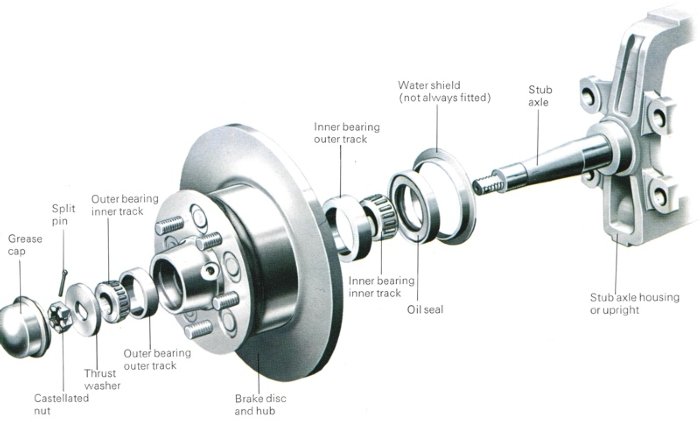Wheel bearings have became one of those components that are now so reliable, they often get overlooked unless there is a problem. Common complaints include grinding, rumbles or an issue with the ABS system. Beside the noises a failed wheel bearing can make, there are many other concerns they can cause such as rotor failure due to vibration, steering issues as well as undesirable tyre wear.
We often think of the job of a wheel bearing to be that of just rotating until it wears out (About 50 million times over the course of 100,000km) but we should remember they have to deal with many forces of axial and radial loads such as acceleration, braking, cornering and gravity to name a few. Not to mention the environmental factors such as brake dust, heat and road grime.
It goes without saying that a quality wheel bearing will outlast it’s cheaper counterpart but when the time comes to replace them, correct procedures are critical.

Tapered Roller Bearings
The tapered roller bearing has very much been the staple wheel bearing on ‘non-driven’ wheels and the most generic type of wheel bearing used until front wheel drive vehicles became commonplace.
The tapered roller bearing consists of a tapered inner race with the rollers being held in place by a cage and cup/outer race. There are generally no integrated seals in a tapered roller bearings and they are generally more expensive to manufacture than ball bearings. Tapered roller bearings are generally better at dealing with imperfections in alignment or fit and handle axial loads better than a ballrace assembly.
Tapered roller bearings are often serviced when doing a brake job and are susceptible to moisture ingress and loss of lubricant. In the event a tapered roller bearing isn’t noisy or rough and does not show any signs of rust or contamination, they can often be regreased by forcing out the old grease with new grease rather than disassembling the bearing.
Beside cleanliness and lubrication the other pivotal aspect of a tapered roller bearing is proper preload. This is generally done by tightening the spindle nut to the correct torque followed by the manufacturer-specific preload procedure and finally installation of the retaining device. The average torque of a tapered roller bearing on a light vehicle is 12ft/lb.
First Generation Cartridge Bearing
Cartridge bearings usually consist of a double-row angular contact bearing assembly. The cartridge bearing is the preferred bearing of choice for small to medium front wheel drive vehicles but are also used on some ‘non-driven’ wheels in the instance of an integral bearing/brake/hub assembly.
Cartridge bearings are comprised of a single outer race, two separate inner races with bearing cages and more often than not, ball bearings. Unlike tapered roller bearings, cartridge bearings are sealed and lubricated for life and do not require servicing. They also often incorporate an impulse ring in the outer seal to provide wheel speed information for ABS.
Sometimes replacing cartridge style bearings can be labour intensive and can require special tools. This is mainly due to the interference type fit into the knuckle assembly. In the event the hub is removed, a hydraulic press can often be used. The outer flange will often require removal and refitment or replacement and care must be taken to ensure no damage occurs.
Technicians should also ensure the bearing is facing the correct way otherwise the no wheel speed signal will be generated for the wheel in question when fitted with an impulse ring. This will often present as an ABS warning light or message after a road test. Just as with the tapered roller bearing, correct torquing is critical. Incorrect torquing of the axle nut on a cartridge wheel bearing is a common cause of premature failure. An impact gun should never be used for this purpose.
Second Generation Cartridge Bearing
The second generation cartridge bearing is much the same as the first generation, however the outer race is now integrated into the flange which provides decreased weight. The second generation cartridge bearing can be found on ‘non-driven’ front and rear wheels of a vehicle and is mounted on a machined spindle. Replacement of this type of bearing is usually simpler than the first generation. It’s important to mention that anti-seize should not be used as it may interfere with proper seating of the bearing and incorrect axle nut torque,
Third Generation Cartridge Bearing
The third generation of wheel bearing incorporates two seperate flanges and a double row angular contact ball bearing design that are again sealed and lubricated for life.
Using two flanges makes for simpler knuckle and suspension design. The outer flange remains fixed and is secure to the knuckle whilst the inner flange rotates. This design is used for both driven and not driven wheels. In the instance of a ‘driven-wheel’ application, the inner race will feature splines to incorporate a driveshaft. Like the previous generations, this type of wheel bearing is also susceptible to failure if improper torque is applied.
Summary
Double row angular contact bearings have now become common place due to their production cost, size, reliability and versatility. Whilst they are generally reliable they can and will fail.
Factors contributing to their failure include age, impact such as curbs, moisture ingress, oversize tyres and wheels and worn suspension.
To ensure successful bearing replacements ensure a clean working environment, proper torque of fasteners and selection of a quality wheel bearing.